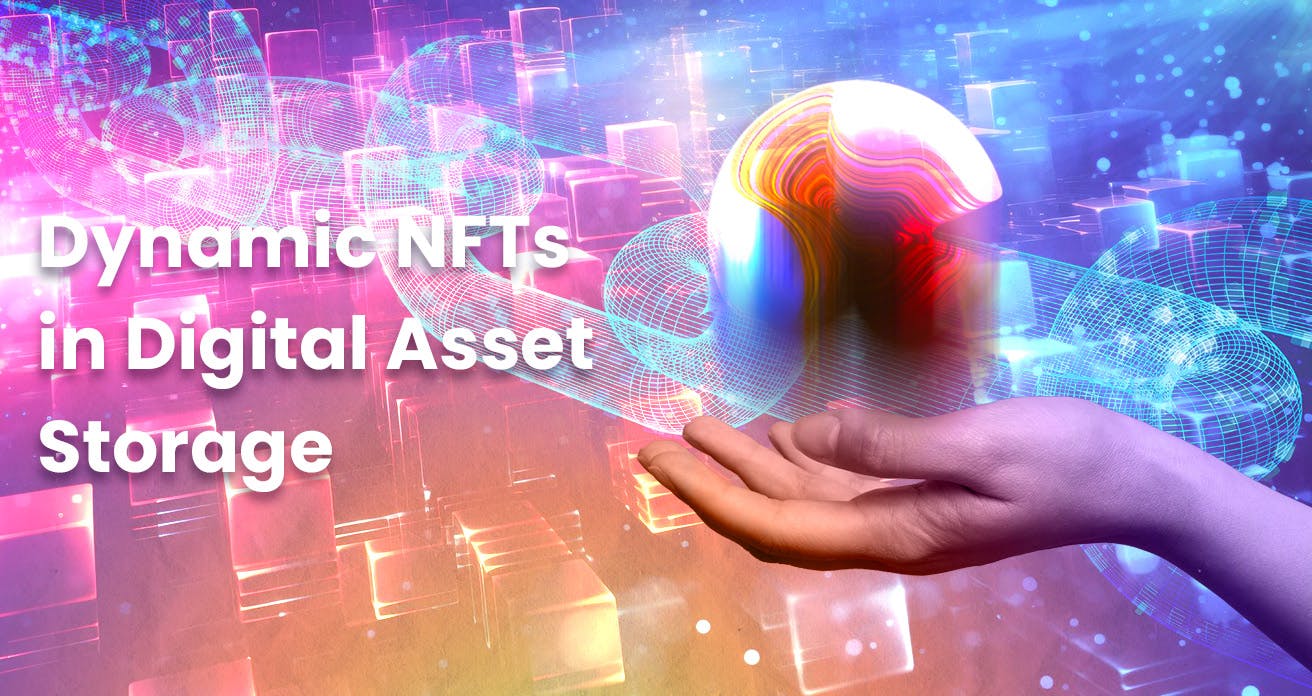Blog

The Significance of Blockchain-Based Dynamic NFTs in Digital Asset Storage
In the ever-evolving landscape of digital assets, the question of where and how to securely store these valuable digital entities is paramount. Two primary methods have emerged: blockchain-based storage and private cloud storage. While both have their merits, the profound importance of blockchain-based storage becomes evident, particularly when it comes to dynamic NFTs (Non-Fungible Tokens) - digital assets that evolve based on user interactions.
Blockchain Storage: A Citadel of Digital Assets Blockchain technology, epitomized by platforms like Ethereum, stands as one of the most secure and transparent ways to house digital assets. This decentralized ledger, distributed across a multitude of nodes, fortifies itself against tampering and censorship with a series of compelling advantages:
-
Transparency: Every transaction on the blockchain is a matter of public record, accessible and verifiable by anyone. This unparalleled transparency ensures the integrity of ownership records, casting a spotlight on every movement within the digital asset realm.
-
Security: At the heart of blockchain security lies cryptographic hashes and consensus mechanisms. These shields make altering past transactions an arduous task, requiring consensus from the entire network. The result is a digital fortress impenetrable to the malicious intentions of bad actors.
-
Decentralization: The blockchain's core principle is its lack of a single controlling entity. This decentralization strengthens security by eliminating a solitary point of failure. Meaning that the blockchain democratizes ownership and safeguards assets against undue influence or manipulation.
-
Ownership Control: The concept of private keys, firmly held by asset owners, is a cornerstone of blockchain storage. These cryptographic keys represent an impenetrable gate, granting exclusive access to one's digital holdings. In a world where digital autonomy is paramount, blockchain storage empowers individuals with true control over their assets.
The Cryptokitties Case: Unmasking Vulnerabilities
The case of CryptoKitties, a beloved decentralized application (DApp) residing on the Ethereum blockchain, serves as an illuminating example of the critical nuances within blockchain-based storage. While Ethereum itself champions decentralization, CryptoKitties brought to light that DApps can harbor vulnerabilities and central points of control, disrupting the idyllic decentralized narrative:
-
Ownership Control Revisited: In CryptoKitties, ownership of these digital felines resides within a solitary contract, controlled by an owner who possesses the power to pause the contract or modify critical facets of the game without the need for consensus. This paradoxical centralization within a decentralized environment exemplifies the potential pitfalls of DApps.
-
Algorithmic Authority: The code dictating the uniqueness of CryptoKitties is far from decentralized; instead, it's subject to the authority of a central figure. This means that the algorithm defining a kitty's traits and attributes can be unilaterally altered, raising questions about the authenticity and permanence of digital assets.
Private Cloud Storage: Convenience Meets Centralization
Contrasting blockchain storage, private cloud storage relies on traditional cloud infrastructure, offered by industry giants like Amazon Web Services (AWS) or Google Cloud. While it delivers scalability and accessibility, it presents a set of distinctions and drawbacks:
-
Centralization Predominates: Private cloud storage leans on centralized infrastructure, thereby tethering itself to the whims of a single entity. This centralized control introduces vulnerabilities and risks associated with undue authority.
-
Ownership Ambiguity: Users engaging in private cloud storage services typically relinquish direct ownership and control over their data and the underlying infrastructure. Instead, they place their trust in service providers to safeguard their digital assets.
-
Transparency Lacks: Unlike the inherent transparency embedded within blockchain's public ledger, private cloud storage operates in a murkier realm. Users are compelled to place their faith in cloud service providers to maintain data integrity.
The Nexus Between Dynamic NFTs and Blockchain Storage So, why does this debate about blockchain-based storage matter, especially concerning dynamic NFTs? The answer lies in the very essence of dynamic NFTs – their evolution based on user interactions. Dynamic NFTs thrive within the secure confines of the blockchain. The blockchain's transparency, security, decentralization, and ownership control provide the ideal canvas for these digital assets to transform and adapt seamlessly. When dynamic NFTs evolve, the entire process is verifiable, tamper-resistant, and immune to external manipulation. It's a journey of digital transformation that users can trust and authenticate, so long as the evolving properties are also stored on-chain.
In the ever-evolving landscape of blockchain-based storage, Freeverse is committed to safeguarding the value and authenticity of dynamic NFTs with Living Assets™. These can adapt their attributes based on user interactions or data metrics, all while ensuring blockchain-certified changes. By seamlessly integrating Living Assets™ into your game or brand, you grant users the power to modify their digital content, enhancing engagement and trust.
Living Assets™ derive their value from utility, not mere scarcity speculation. Freeverse's commitment to this technology aligns with our mission to enhance digital ownership. In an era where trust and authenticity matter most, Living Assets™ ensures that their value remains rooted in their utility and the blockchain's security.
In contrast, private cloud storage, while offering merits in other contexts, lacks the robust transparency and decentralization required for dynamic NFTs to thrive securely. It introduces ambiguities in ownership and control and fails to provide the same level of confidence in the evolutionary process.
In the intricate landscape of digital asset storage, blockchain-based storage emerges as the main pillar of trust and security, particularly when dynamic NFTs are in play. As these unique digital entities evolve, adapt, and respond to user interactions, the blockchain stands as a sentinel, ensuring every transformation is authentic, tamper-proof, and resistant to centralized whims. Embracing blockchain-based storage is not just a choice; it's a commitment to the preservation of the authenticity and value of dynamic NFTs in the dynamic world of digital ownership. In this ever-evolving digital era, trust is the ultimate currency, and blockchain storage is the vault that safeguards it.

